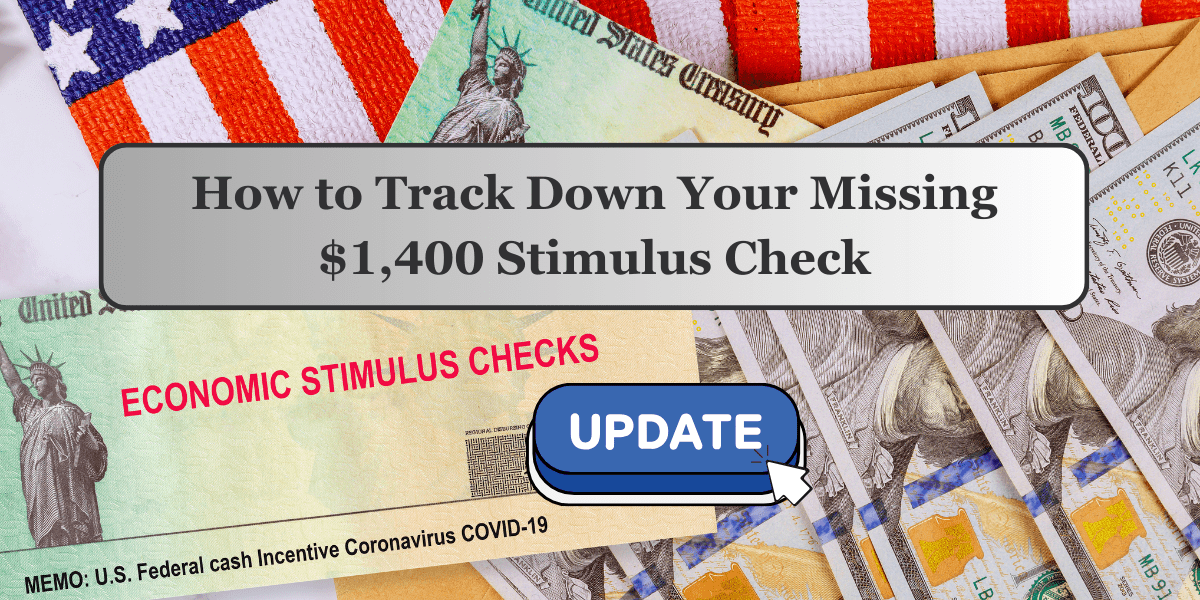The stimulus payments provided by the IRS have been a lifeline for millions of Americans during challenging times. Since March, over 167 million payments have been distributed, but not everyone has received their money. If you’re one of those who qualify but have yet to receive your payment, or if you suspect your payment might be lost, you might be feeling frustrated and anxious.
In this guide, we’ll walk you through everything you need to know about tracking down your missing stimulus check. From understanding when to request an IRS payment trace to the steps involved in filing for a recovery rebate credit, we’ve got you covered.
Table of Contents
When Should You Start Worrying About a Missing $1,400 Stimulus Check?
If you haven’t received your $1,400 stimulus check yet, you might be wondering if it’s time to start worrying. The IRS has been sending out payments in batches, so yours may be still on the way. However, if you’ve received a letter from the IRS stating that your payment was sent, but you haven’t received it, it’s time to take action.
| ontario trillium benefit payment dates 2024 |
| ctc monthly payments schedule |
| 300 child tax credit |
| ctc deposit date fixed |
| 2024 child tax credit |
Possible Issues with Your Stimulus Check
There are several reasons why your stimulus check might be missing:
- Wrong Mailing Address: The IRS might have the wrong mailing address on file.
- Lost in Mail: The check could be lost in the mail.
- Bank Account Issues: If the IRS tries to deposit the money into a closed or incorrect bank account, it might be delayed.
- “Plus-Up” Payments: If you received less than the expected amount, you might be owed a “plus-up” payment, which adjusts your stimulus amount based on your 2020 tax return.
In these cases, you may need to track down your payment.
How to Request an IRS Payment Trace
If you suspect that your stimulus check is lost, the IRS allows you to request a payment trace. A payment trace is designed to track down a check that the IRS says it has sent, but you haven’t received. Here’s when you should request an IRS payment trace based on the method of payment:
| Method of Payment | Time Passed Since IRS Sent Payment |
|---|---|
| Direct Deposit | 5 days |
| Check mailed to a standard address | 4 weeks |
| Check mailed to a forwarded address | 6 weeks |
| Check mailed to a foreign address | 9 weeks |
If the time elapsed exceeds the period mentioned above, you can request a payment trace. Here’s how you can do it:
Steps to Request a Payment Trace
- Use the IRS Get My Payment Tool:
- Visit the IRS website and use the Get My Payment tool to check the status of your payment. You’ll need to enter your Social Security number (SSN) or Individual Taxpayer Identification Number (ITIN), date of birth, street address, and ZIP code.
- Check Your IRS Letter:
- About 15 days after the IRS sends your stimulus payment, they will mail you a letter (Notice 1444) confirming your payment. Keep this letter as you’ll need the information to request a payment trace.
- Call the IRS:
- You can call the IRS at 800-919-9835 to request a payment trace. Be prepared to listen to recorded content before being connected with an agent.
- Fill Out IRS Form 3911:
- Alternatively, you can mail or fax a completed Form 3911 (Taxpayer Statement Regarding Refund). Here’s how to fill it out for your third stimulus check:
- Write “EIP3” at the top of the form.
- Complete all the refund questions related to your payment.
- For item 7 under Section 1:
- Check the box for “Individual” as the Type of Return.
- Enter “2021” as the Tax Period.
- Do not write anything for the Date Filed.
- Sign the form. If you’re married and filing jointly, both spouses must sign.
- Alternatively, you can mail or fax a completed Form 3911 (Taxpayer Statement Regarding Refund). Here’s how to fill it out for your third stimulus check:
What Happens After You Request a Payment Trace?
Once you’ve requested a payment trace, the IRS will begin processing your claim. Here’s what you can expect:
- Uncashed Check:
- If your check hasn’t been cashed, the IRS will issue a replacement. If you find the original check later, you must return it.
- Cashed Check:
- If your check was cashed, the IRS will send you a claim package from the Bureau of the Fiscal Service, including a copy of the cashed check. You’ll need to follow the instructions in the package. The Bureau will review your claim and the signature on the canceled check to determine if a replacement should be issued. This step helps prevent stimulus check fraud.
How Long Will It Take?
The IRS typically responds within six weeks after receiving your request for a payment trace. However, delays are possible due to limited staffing and high demand.
Filing for a Recovery Rebate Credit
If your first or second stimulus check is missing, and you can’t use the Get My Payment tool to track it down, you can file for a Recovery Rebate Credit on your 2020 tax return. The Recovery Rebate Credit allows you to claim any missing stimulus money you were eligible for but didn’t receive.
Steps to File for Recovery Rebate Credit
- Check Your Eligibility:
- Use the IRS’s Recovery Rebate Credit Worksheet to determine your eligibility and calculate the amount you should claim.
- File a 2020 Tax Return:
- If you haven’t filed your 2020 tax return yet, you can claim the Recovery Rebate Credit directly on your return. If you already filed and didn’t claim the credit, you can file an amended return.
- Use Form 1040 or 1040-SR:
- Enter the amount of the credit on line 30 of Form 1040 or 1040-SR.
What If You Don’t Normally File Taxes?
Even if you don’t normally file taxes, you can still claim the Recovery Rebate Credit by filing a 2020 tax return. This applies to non-filers, including those with low or no income who didn’t receive their stimulus payments.
What If You Received Unemployment Benefits in 2020?
If you received unemployment benefits in 2020, you might be eligible for a significant tax break. The American Rescue Plan Act excludes up to $10,200 of unemployment benefits from taxable income for individuals with an adjusted gross income of less than $150,000.
How to Claim the Unemployment Tax Break
- Check Your 2020 Tax Return:
- If you already filed your 2020 tax return before the tax law changed, the IRS will automatically refund the difference. You don’t need to file an amended return unless you’re eligible for additional credits or deductions due to the adjustment.
- Wait for IRS Notification:
- The IRS will notify you if you’re eligible for a refund due to the unemployment tax break. If you’re eligible, you should receive your refund in the mail or via direct deposit.
Looking Ahead: A Possible Fourth Stimulus Payment?
While the third stimulus payment has been a relief for many, there’s speculation about a potential fourth stimulus check. As of now, there are no official plans for a fourth payment, but the situation is fluid, and it’s worth keeping an eye on future legislative developments.
Child Tax Credit Payments Starting in July 2024
In addition to the stimulus checks, many families are eligible for the enhanced Child Tax Credit. Starting in July 2024, eligible families can receive up to $3,600 per child. These payments will be distributed monthly through December 2024, with the remaining half available as a tax credit when you file your 2024 tax return.
Conclusion
If you’re still waiting on your stimulus check, it’s important to take the necessary steps to track it down. Whether it’s requesting a payment trace, filing for a Recovery Rebate Credit, or claiming a tax break on unemployment benefits, the IRS has procedures in place to ensure you get the money you’re entitled to.
With ongoing updates and potential new relief packages on the horizon, staying informed is key. Keep checking the IRS website, use the Get My Payment tool, and consult with a tax professional if you have any concerns or questions. Financial relief is available; you just need to know how to access it.




